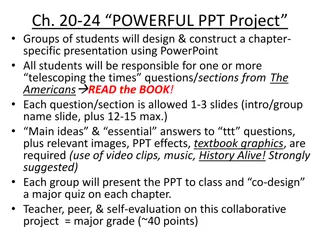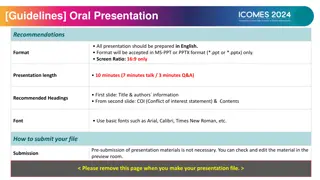
Energy, Capacitance, and Dielectrics in Capacitors
Explore the concepts of energy storage, capacitance, dielectric materials, and electric fields in capacitors. Learn about the properties and behavior of capacitors with various configurations, charges, potentials, and breakdown scenarios. Dive into calculating potential difference, capacitance, and understanding how dielectric materials influence these parameters in capacitor systems.
Download Presentation

Please find below an Image/Link to download the presentation.
The content on the website is provided AS IS for your information and personal use only. It may not be sold, licensed, or shared on other websites without obtaining consent from the author. If you encounter any issues during the download, it is possible that the publisher has removed the file from their server.
You are allowed to download the files provided on this website for personal or commercial use, subject to the condition that they are used lawfully. All files are the property of their respective owners.
The content on the website is provided AS IS for your information and personal use only. It may not be sold, licensed, or shared on other websites without obtaining consent from the author.
E N D
Presentation Transcript
The energy stored in a parallel plate capacitor is A. equal to the work required to charge it B. CV2 C. equal to the average potential difference multiplied by the final charge D. all of the above E. none of the above 0% 0% 0% 0% 0% CV2 all of the above none of the above equal to the work requir.. equal to the average pot...
Energy can be stored in a vacuum. A. True B. False 0% 0% True False
The capacitance of a capacitor of a given dimension is _______ when there is a dielectric material between the plates than when there is air or vacuum. A. greater B. less C. the same 0% 0% 0% less greater the same
The potential across a capacitor of a given dimension is _______ when there is a dielectric material between the plates than when there is air or vacuum. A. greater B. less C. the same 0% 0% 0% less greater the same
The charges on the plates of a capacitor of a given dimension is _______ when there is a dielectric material between the plates than when there is air or vacuum. A. greater B. less C. the same 0% 0% 0% less greater the same
Due to dielectric breakdown, when a dielectric material is subjected to a sufficiently strong electric field, it becomes a(n) ________. A. Insulator B. conductor 0% 0% Insulator conductor
The plates of a parallel-plate capacitor are 2.50 mm apart, each carrying a charge of magnitude 80.0 nC. The plates are in a vacuum and the electric fields between the plates has a magnitude of 4.00 x 106 V/m. What is the potential difference between the plates (in V)? Rank Responses 1 2 3 4 5 6 0% 0% 0% 0% 0% 0% 1 2 3 4 5 6
The plates of a parallel-plate capacitor are 2.50 mm apart, each carrying a charge of magnitude 80.0 nC. The plates are in a vacuum and the electric fields between the plates has a magnitude of 4.00 x 106 V/m. What is the capacitance (in pF)? Rank Responses 1 2 3 4 5 6 0% 0% 0% 0% 0% 0% 1 2 3 4 5 6
A 12.5 F capacitor is connected to a power supply that keeps a constant potential difference of 24.0 V across the plates. A piece of material having a dielectric constant of 3.75 is placed between the plates, filling the space. How much energy is stored in the capacitor before the material was inserted (in mJ)? Rank Responses 1 2 3 4 5 6 0% 0% 0% 0% 0% 0% 1 2 3 4 5 6
A 12.5 F capacitor is connected to a power supply that keeps a constant potential difference of 24.0 V across the plates. A piece of material having a dielectric constant of 3.75 is placed between the plates, filling the space. How much energy is stored in the capacitor after the material was inserted (in mJ)? Rank Responses 1 2 3 4 5 6 0% 0% 0% 0% 0% 0% 1 2 3 4 5 6






















